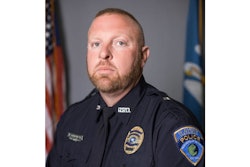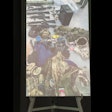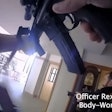 Heidi Sievers, a forensics expert and Columbia Southern University professor, works with her human remains detection K-9. Dogs are often used in search and recover after a natural or man-made disaster.Heidi Sievers
Heidi Sievers, a forensics expert and Columbia Southern University professor, works with her human remains detection K-9. Dogs are often used in search and recover after a natural or man-made disaster.Heidi Sievers
As another year continues, the United States has seen several natural and manmade disasters and may likely have to brace for more. In the first half of 2025, the U.S. experienced natural disaster costs exceeding $125 billion, according to a report from Aon.
Whether fatalities are caused by natural disasters, transportation accidents, armed conflict, or acts of terrorism, the imperative to identify victims swiftly, accurately, and respectfully transcends operational necessity. It is a moral, legal, and humanitarian obligation.
Disaster victim identification (DVI) is a multidisciplinary endeavor. Within this collaboration, the role of forensic science remains, in many contexts, underrepresented. While emergency management protocols often highlight the importance of logistics, public health coordination, and scene security, the forensic sciences provide a unique and indispensable suite of capabilities that elevate the identification process from provisional recognition to scientific clarity.
Forensic specialists bring rigor, precision, and methodological discipline to the DVI process. Their contributions begin at the scene. Forensic search and recovery teams, whether employing traditional search techniques or utilizing a human remains detection (HRD) K-9, can locate and recover remains with a degree of accuracy that mitigates the loss of evidence and preserves the integrity of the identification chain.
Science Helps Bridge Gaps
Once recovered, anthropologists are typically relied upon to apply osteological and taphonomic (examination of changes to organic remains after death) expertise to interpret the profile of the deceased, often reconstructing the identity from fragmentary or degraded remains.
This scientific work bridges critical gaps when visual recognition, one of the least reliable methods of identification, is rendered impossible by the conditions of the disaster.
Watch: Heidi Sievers – Working with Crime Scene Investigators
Central to the forensic role is the integration of antemortem and postmortem data, which draw on sources such as dental records, medical imaging, fingerprints, and DNA profiles. These methods are augmented through collaboration with pathologists, odontologists, and biologists. Thus, creating a scientifically defensible identification process that withstands both legal scrutiny and ethical examination, minimizing the likelihood of blinders to outside variables.
Such interdisciplinary engagement ensures that identification is not reliant on non-scientific approaches, such as clothing or personal-effect recognition, which are prone to error and undue influence, perpetuating misidentification.
The inclusion of forensics in DVI efforts supports a broader societal function: restoring dignity to the deceased and providing closure to the bereaved. The deployment of anthropological techniques to reconstruct events, combined with the objective reliability of genetic and biometric evidence, embodies the intersection of compassion and empirical science.
Forensics Serves the Needs of the Case
In situations where traditional ink-and-card printing methods are not available due to advanced decomposition, injury, or skin slippage, forensic experts are able to employ highly sophisticated techniques, such as rehydration, to render ridge detail suitable for comparison.
These actions demonstrate a dedication to providing a scientifically valid identification that serves the needs of the case, offers closure to grieving families, and restores the dignity of bringing a name back to the unidentified.
This role is not merely reactive, but increasingly proactive, as forensic professionals contribute to preparedness planning, the development of search and recovery protocols, and the integration of emerging technologies, such as 3D imaging and geospatial mapping.
Geospatial mapping is the process of capturing, storing, analyzing, and visualizing geographic data to understand spatial relationships and patterns. It involves creating maps and other visualizations that represent real-world locations and features.
The ability to effectively deploy forensic professionals in DVI situations is not a matter of general competency; it is the result of intentional, specialized training designed to meet the unique challenges of local, state, and federal operations.
These deployments require a mastery of technical skills such as advanced recovery methods, scene processing under hazardous or unstable conditions, and the application of multiple scientific identification modalities.
Equally critical is the capacity to operate within the structured framework of various DVI protocols, including Interpol or the National Disaster Medical System, ensuring seamless integration with multidisciplinary teams.
Preparation Is Key for Precision
Training must also address the physical, logistical, and psychological demands of deployment, preparing professionals to work in high-pressure environments where accuracy, efficiency, and compassion are paramount. By investing in targeted preparation, agencies ensure that forensic specialists can respond with competence and precision at every operational level, ultimately strengthening the DVI mission.
Forensic sciences are not ancillary to disaster victim identification; they are foundational. To overlook their inclusion in DVI planning and execution is to risk undermining both the accuracy of identification and the trust of the communities served.
The discipline’s capacity to merge field-recovery expertise, advanced scientific methodologies, and interdisciplinary collaboration positions forensics as an essential pillar in any comprehensive disaster response framework.
It is incumbent upon policymakers, emergency managers, and investigative authorities to recognize, institutionalize, and resource this role. This ensures that science, as much as compassion, guides the solemn task of returning the deceased to their loved ones.
Heidi Sievers holds a doctorate in criminal justice and a master’s degree in forensics. She is an International for Identification Certified Crime Scene Analyst and Certified Bloodstain Pattern Analyst, one of 65 worldwide. She is a former forensic investigator and human remains detection K-9 handler from West Central Florida. She teaches at Columbia Southern University and operates Sievers Forensics, which provides forensic and bloodstain pattern analysis training and consultation.
Learn More: Law Enforcement Disaster Resilience Begins with Communications














